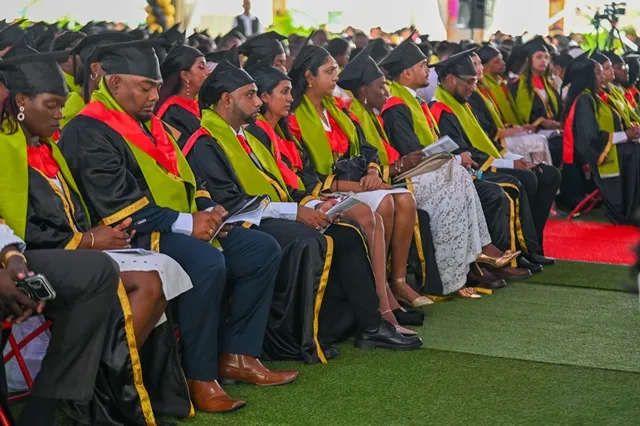Introduction
Guyana’s economy is experiencing an unprecedented boom, transforming one of South America’s historically poorest nations into its fastest-growing economy, America Fueled by vast offshore oil discoveries, GDP growth has surged at extraordinary rates – averaging over 42% annually since 2020. In 2022 alone, real GDP jumped 63.4% as new oil production came online worldbank.org. This explosive expansion has tripled GDP per capita from about US$6,500 in 2019 to over US$18,000 in 2022, moving Guyana rapidly up the income ladder. Such figures are astonishing, but they tell only part of the story. Beneath the headline numbers lies a nation at an economic crossroads – balancing oil-driven prosperity with sustainable, inclusive development. In this piece, we delve into the current state and projected trajectory of Guyana’s economy, examining the opportunities and challenges that lie ahead.
An Oil-Fueled Boom
Guyana’s economic takeoff is overwhelmingly powered by its young petroleum sector. Since ExxonMobil’s first major oil find in 2015, the country has proven over 11 billion barrels of reserves. Production began in late 2019 and ramped up to 278,000 barrels per day in 2022. With multiple new offshore fields slated to come online, growth remained double-digit in 2023 and 2024 and is forecast around 14% in 2025. By 2025, crude output is expected to reach 1.4 million barrels per day, capping an almost six-fold increase from current levels. This oil boom has supercharged export earnings and government revenues, giving Guyana the world’s highest oil reserves per capita and making it a newfound petro-economic powerhouse.

The immediate impacts are visible across macroeconomic indicators. Nominal GDP has ballooned to an estimated $24.5 billion in 2025, a 410% increase from 2018. The IMF projects robust growth of +14% for 2025 on top of the staggering +44% in 2024. Oil now dominates the economy, accounting for 88% of export value in 2022. Foreign direct investment has poured in as well – Guyana attracted US$7.2 billion of FDI in 2023, a 64% jump over 2022, making it the 6th largest FDI recipient in Latin America that year These inflows, largely in oil and gas, comprised an astonishing 64% of all FDI into the Caribbean in 2023. Government finances have correspondingly strengthened, enabling record budgets over GY$1 trillion (around US$5 billion) focused on infrastructure and social programs.
Diversification and Sustainability
Amid this bonanza, Guyana’s leadership is keenly aware of the “resource curse” pitfalls. A central challenge is economic diversification beyond oil. As the World Bank notes, the country remains heavily dependent on a few commodities – outside of petroleum, just six products (gold, rice, sugar, bauxite, timber, shrimp) make up 90% of non-oil exports. Broadening the economic base is critical to buffer against volatile oil prices and ensure long-term resilience. “Structural reforms are critical to diversify the domestic economy and ensure sustainable, broad-based growth,” the World Bank urges.
The government, led by the PPP/C administration, has launched an aggressive diversification drive. Key initiatives include investing oil revenues into infrastructure – nearly GY$204 billion was budgeted in 2024 for roads and bridges across all regions – and targeting growth in non-oil sectors like agriculture, mining, tourism, and manufacturing. In agriculture, budget allocations rose from GY$13.3B in 2019 to GY$32.2B in 2023 (a 150% increase) to boost food production. President Irfaan Ali, who also leads agriculture for CARICOM, envisions Guyana becoming a regional “food hub” and key exporteren, leveraging its fertile lands to supply Caribbean markets. Manufacturing and industrial development are also being courted by improving energy access and transportation networks – for example, a massive Gas-to-Energy project (bringing natural gas onshore via 200-km pipeline) will halve electricity costs by 2025, enhancing competitiveness for local industry Oil revenues are further being funneled into human capital. The government has rolled out free education initiatives (discussed in detail in a later article) and technical training programs. Over 29,000 Guyanese have received online scholarships through the GOAL program since 2021, and vocational training is expanding to address labor skill gaps. These investments aim to equip the workforce for new opportunities in a diversifying economy.

Managing Inflation and Investment
Rapid growth has come with inflationary pressures and capacity constraints. Inflation hovered around 5% in 2023–2024, moderate but requiring vigilance to protect living costs. The government has tried to cushion consumers through measures like fuel subsidies and monitoring of food prices. Unemployment (excluding short-term oil jobs) remains in double digits at ~12%, indicating slack to be absorbed in the non-oil economy.
On the upside, public investments in infrastructure are kickstarting broader economic activity. The construction sector is booming – evidenced by new highways, bridges, hotels, and housing developments nationwide. For example, the transformative New Demerara River Bridge (GY$19.7B allocated in 2024) and hundreds of kilometers of upgraded highways will improve connectivity. Over $60 billion GY was spent just in 2023 on community roads in all 10 regions, with an even larger sum budgeted for 2024 to rehabilitate thousands more village roads. These projects not only employ many Guyanese in the short term but also lay the foundation for private-sector expansion (e.g. easier transport for agriculture produce, improved access to interior mining areas, and reduced logistics costs for businesses).
The fiscal outlook remains solid. Oil revenues flowing into the sovereign Natural Resource Fund (NRF) give the government fiscal space to invest while maintaining stability. As of late 2024 the NRF held over US$1.4 billion, and withdrawals are guided by a fiscal rule to prevent overspending. The 2025 budget – Guyana’s largest ever at GY$1.08 trillion – still projects a manageable deficit around 2.9% of GDP, indicating prudence in ramping up spending. External public debt is relatively low (under 30% of GDP) and concessional, keeping risks in check. With continued high oil production, Guyana is expected to run current account surpluses and accumulate substantial foreign reserves, further strengthening its financial position.
Inclusive Growth – Reaching Every Guyanese
A critical question is whether this economic boom is benefiting ordinary Guyanese across all walks of life. Poverty, while declining, remains a concern. The last official data (2019) pegged the poverty rate at 48.4% (based on $5.50/day line), down from 61% in 2006. That was before oil revenue distribution began. Since 2020, the government has implemented cash grants, salary hikes, and social programs aimed at sharing the oil wealth (discussed further in the next article on oil wealth distribution). Anecdotally, many families have seen incomes rise – through new oil-sector jobs, better prices for produce with improved infrastructure, or direct transfers like the “Because We Care” education grant for children. The IMF noted that targeted cash transfers in recent years have helped raise disposable incomes and likely reduced poverty further, calling them “an essential tool in fostering inclusive growth”
Infrastructure upgrades are also improving quality of life. In previously neglected hinterland villages, solar panels and new roads are connecting communities to electricity and markets for the first time. The government reports that since 2020 it has installed over 30,000 solar home systems in remote areas, expanded clean water access, and built or upgraded dozens of health centers and schools countrywide. In Region 10 (Upper Demerara-Berbice), a traditionally underserved area, more than GY$30 billion has been invested in development projects since 2020, significantly improving local infrastructure and services. These developments illustrate a commitment to spreading the gains beyond Georgetown’s urban core.
Of course, inequities persist. The cost of living has risen for many, especially in the capital where an influx of foreign workers has driven up housing costs and services. Rural farmers face challenges from climate-related flooding and need support to boost production. And youth entering the job market seek training to access skilled positions in the new economy. The administration is tackling these issues via a multi-pronged “One Guyana” strategy: investing in flood control and climate resilience, expanding technical and vocational education, and fostering entrepreneurship (such as small business grants and start-up incubators for youths).
Looking Ahead
Guyana’s economic prospects remain extremely bright, albeit not without risks. The IMF projects real GDP growth averaging around 10% annually through 2025 and staying high beyond If managed wisely, oil revenues can continue to fund transformative investments for the next decade, lifting thousands out of poverty and modernizing the nation’s infrastructure. By 2030, Guyana could potentially achieve high-middle-income status and sharply improved human development indicators.
However, prudent management and diversification are paramount to avoid over-reliance on oil. The government’s development plan – outlined in its Low Carbon Development Strategy and successive budgets – recognizes this. It emphasizes using the “short-term oil windfall to finance long-term sustainable growth”, in President Ali’s words. That means channeling funds into sectors that can thrive beyond oil, like agro-processing, mining, ecotourism, renewable energy, and technology. Already, strides in these areas are visible: a burgeoning tech sector is on the horizon with a planned National Innovation Centre (in partnership with the University of California, Berkeley) to spur research and startups. Meanwhile, the push for regional food security (Guyana leads CARICOM’s initiative to cut food imports by 25% by 2025) is stimulating large-scale farming and agro-industry.
In summary, Guyana stands at an economic crossroads with an historic opportunity to secure prosperity for its people. The current trajectory is overwhelmingly positive – one of rapid growth, rising incomes, and expansive development. The challenge will be maintaining momentum once the initial oil frenzy stabilizes, and ensuring that the benefits are felt equitably across society. If Guyana stays the course of sound management, transparency, and diversification, its future indeed looks bright. As the IMF recently noted, the country’s multifaceted strategy under the PPP/C government is building “economic resilience and workforce empowerment” and positioning Guyana as a model of sustainable development in the region. The coming years will be critical to cement this foundation and truly transform Guyana’s economic boom into lasting prosperity for all its citizens.
- GOAL Scholarship Programme Surpasses Target as Thousands Graduate
- 30 Years After Legalising Abortion, Activists Urge Action to Fulfill Promise of Safe Access
- Scholarships Provided by the Government of Guyana: Empowering Citizens Through Education
- Police seek foreign suspects after bomb blasts rock city outpost




